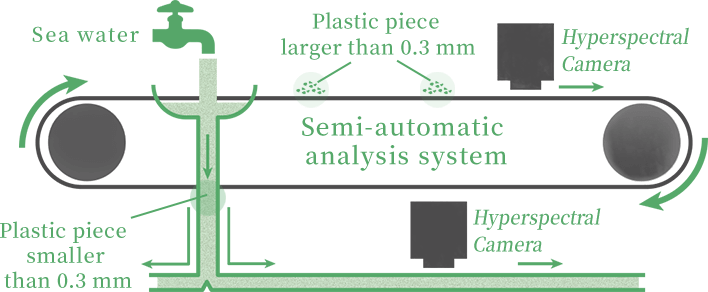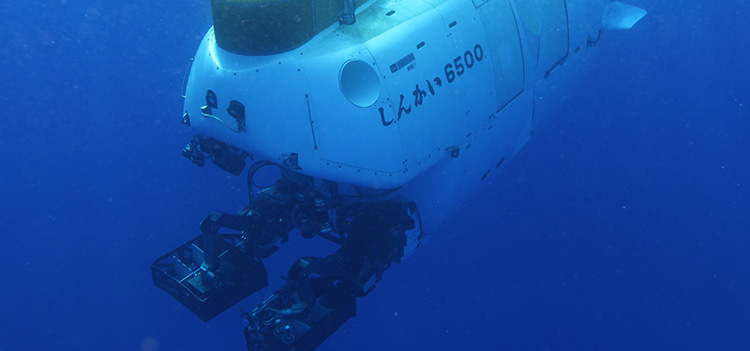Fill the Knowledge Gaps on Marine Plastics
and Working with Multiple Sectors
JAMSTEC is conducting marine plastic researchers to fill the current knowledge gap with particular focus on under-observed areas and the deep-sea, and develop innovative technology to ensure timely and high quality data production.
As marine plastics pollution is transboundary and relevant to various societal and political aspects, we also put an emphasis on promotion of collaboration with communities in multiple stakeholders including policy, private sector and civil society in Japan and internationally.

Fill the Knowledge Gaps
of Marine Plastics
Shipboard Survey
― Research Cruise by R/V YOKOSUKA.

To understand the distribution of plastics in the vast ocean, JAMSTEC conducts shipboard survey to collect plastic samples from surface water to deep-sea. In 2019, we conducted a research cruise with the Research Vessel YOKOSUKA and deep-sea submersible SHINKAI 6500 in Sagami Bay and the Izu-Ogasawara Trench.
Floating microplastics on the sea surface are collected using a plankton net, Neuston net. The net is towed from a vessel to collect plastic debris larger than 0.3 millimeters (3/256 in.) that draft near the surface.

We also investigated the plastics that have reached the ocean floor and accumulated in the deep-sea sediments. We collected sea floor debris and sediments using a human-operated deep-sea submersible SHINKAI 6500 for depths up to 6,500 meters. Free-fall Camera System, which was newly developed by JAMSTEC, was used for collection of sediment samples from the deeper ocean (6,500 to 9,200 meters or 21,325 to 30,183 feet).


Technology Development
― for Effective Analysis of Microplastics
To analyze numbers, shapes and materials of microplastics quickly and accurately, JAMSTEC is developing a semi-automatic microplastic measurement system using a hyperspectral imaging technique. This project is funded by the program Marine Resource Utilization Promotion and Technical Development Program – “Technology development for monitoring marine microplastic pollution”, of the Ministry of Education, Culture, Sports, Science and Technology.


Hyperspectral Camera can detect the spectral patterns that are specific to the materials used in plastics. We are developing the system that enables us to measure the number, size and materials used in the microplastics quickly and accurately, by coupling the Hyperspectral Camera with a semi-automatic sample sorting system and image analysis tool using AI.

Theoretical Research
―Structuring the Problem of Marine Plastics from a Physical Perspective―
We are developing a theory to understand, in a structured way, how plastics break down, spread out, sink, and are incorporated into the ecosystem in the ocean. As well as contributing to assessing the environmental impact of marine plastics, we are exploring basic science.
Fragmentation simulation
Theoretical model
We have proposed a theoretical model that predicts the size and amount of microplastics generated depending on the strength of the force applied to the original large plastic pieces. By examining the detailed process of fragmentation and the relationship between weather phenomena (waves and winds) and fragmentation based on this model, we will be advancing the development of a more realistic dispersion simulation.
Collaboration with Multiple Sectors
― Observation During Japan-Palau Goodwill Yacht Race
To increase coverage of ocean observation, collaboration with multiple sectors, and use of volunteer ships such as tankers, ferries and pleasure boats are attracting much attention. We launched a collaborative research project on the Japan-Palau Goodwill Yacht Race, which will be held between December 2019 and January 2020. In cooperation with organizations of multiple sectors, we equip semi-automated microplastic samplers on the racing yacht TREKKEE and race Escort ship MIRAIE to monitor microplastic distribution during the race.


JAMSTEC researchers are onboard the MIRAIE for conducting sampling. We also have a series of ocean literacy program for children and their families from Palau who will join the cruise.
Data Sharing – Deep-sea Debris Database
JAMSTEC launched the Deep-sea Debris Database for public use in 2017. The users can download for free the information and photos/video footages collected by JAMSTEC’s deep-sea research vehicles including SHINKAI 6500 and SHINKAI 2000 since 1980s.
Image of Suruga Bay
Image of Mariana Trench
You will find approximately 3,200 images, such as dozens of plastic bags adrift 2,400 meters (7,874 feet) deep in Suruga Bay, and plastic pieces in the Mariana Trench at a depth of 10,900 meters (35,761 feet). The database attracts much attention of the global community as the first extensive data sets of deep-sea debris, which is useful for better understanding of its distribution in the world ocean. It also helps arouse the awareness on the threat of marine debris in society.
Ocean Literacy Program
Education
― Program to Learn About and Experience Marine Waste
GODAC (Global Oceanographic Data Center), one of the JAMSTEC facilities in Okinawa prefecture, organizes a seminar series for all age groups, and produces various learning materials.

GODAC Seminar is held four times a year for students to be able to learn about the latest scientific findings by JAMSTEC. In 2018, a seminar entitled “What’s Marine Debris?” was held to learn about the characteristics of marine plastics through lectures and experiments. GODAC sends science interpreters to schools anywhere in Okinawa prefecture upon request to provide lessons on marine plastics.


Citizen Science
― Collaboration with Marient Marine Museum
JAMSTEC has education programs to promote citizen science on marine plastics. In collaboration with Marient Marine Museum located in Aomori prefecture, we invited school children of “Marient Chikyu Tanken Club” (Earth Exploration Club)” to the laboratory of JAMSTEC’s deep sea drilling vessel CHIKYU, to learn how to analyze microplastics using samples they collected on the local beach.


Being interested in marine plastics, the children continued studies on plastics on their local beach. The findings of their research were presented at a scientific conference of JpGU (Japan Geoscience Union). JAMSTEC helped them prepare their presentation and obtain skill in answering to questions.
Toward Future
The world leaders have pledged to reduce additional pollution by marine plastic waste to zero by 2050 in the Osaka Blue Ocean Vision issued at the G20 Osaka Summit in 2019. The role of science to provide credible evidence for effective policy making has been growing.
To make this possible, the establishment of a global observation network on marine plastics is needed to fill the current knowledge and geographical coverage gaps. Marine plastic pollution is a transboundary issue that no single nation or organization can solve. While data in the sea surface and coastal ocean has been accumulated by regional and national programs, the international mechanisms for standardization of observation methods and data sharing are much awaited to be formed.
Technological innovation in collecting and measuring finer microplastics is one of the other challenges needed to fill the current knowledge gap in missing plastics.
The plastic lifecycle flowing from land to coast, coast to open ocean and ending up in the deep-sea, currently and in the future, should be investigated through observation and numerical models.
The negative impact of micro and nano-plastics on biology and physiology of individual organisms and the entire ecosystem, are demanding but one of the least known subjects.
The tasks that marine science needs to tackle are massive.
Marine plastic pollution is one of the urgent global environmental issues that marine ecosystems and human society are facing. We must tackle marine plastics pollution together with other global environmental challenges with the world community across geographical borders, societal and industrial sectors and academic disciplines.

